How to implement self-management strategies in therapy

Unlocking Patient Independence with Self-Management Strategies
Self-management is a vital component of modern therapy, enabling individuals to take control of their behaviors, emotions, and health outcomes. By integrating evidence-based techniques, therapists can facilitate sustainable behavioral changes, improve quality of life, and foster independence. This article explores effective strategies for implementing self-management within therapeutic settings, emphasizing practical steps, key components, and the critical role of self-regulation skills.
Understanding Self-Management in Therapy
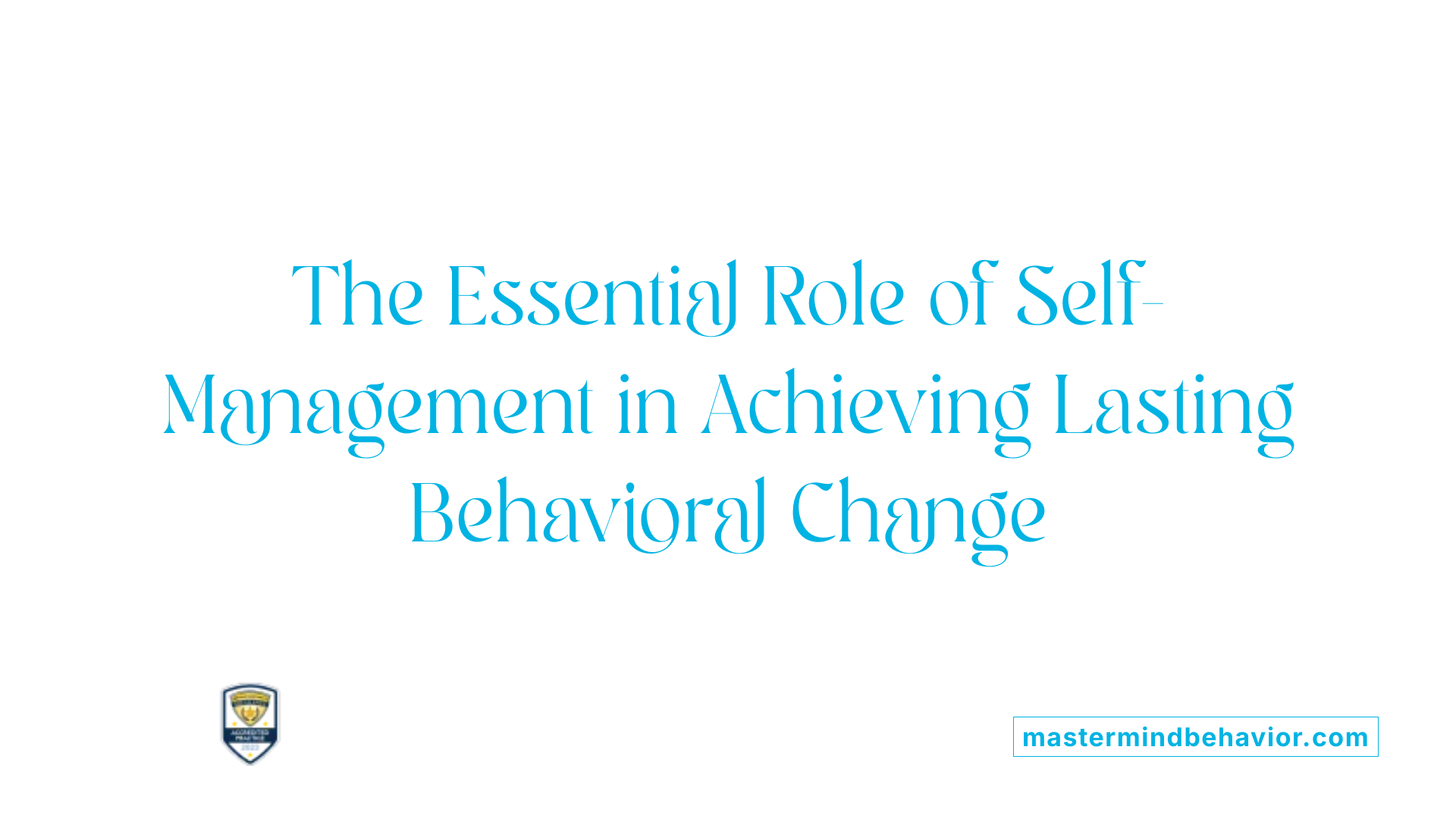
What is self-management in therapy?
Self-management in therapy encompasses a variety of techniques designed to help individuals take control of their own behaviors. It involves actively applying strategies such as goal setting, self-monitoring, self-evaluation, self-reinforcement, and self-instruction. These components work together to foster independence, enabling individuals to regulate their actions without requiring constant external support.
Rooted in applied behavior analysis (ABA), the approach leverages evidence-based practices supported by extensive research. It is particularly effective for supporting individuals with autism spectrum disorder (ASD), managing chronic health conditions, and addressing behavioral challenges. The ultimate aim of self-management is to promote durable behavioral change by empowering individuals to influence their environment and maintain adaptive behaviors over time.
In practice, self-management techniques involve individuals actively engaging in planning, recording, analyzing, and reinforcing their own behaviors. Therapists and other professionals often guide initial stages of implementation, but the emphasis is on developing personal skills that lead to lasting self-control and independence.
How does self-management relate to self-regulation skills?
Self-management is closely linked to the broader concept of self-regulation. Self-regulation involves controlling one's emotions, thoughts, and impulses in the moment to achieve specific goals. It includes skills like impulse control, emotional regulation, stress management, and perseverance.
While self-regulation focuses on immediate, in-the-moment control, self-management extends this with a strategic, long-term perspective. It involves applying self-regulation skills over time to modify behaviors, sustain motivation, and achieve desired outcomes. Techniques such as self-monitoring, mindfulness practices, and habit development strengthen both self-regulation and self-management.
An example is using self-monitoring tools—like journals or apps—to track behaviors, which enhances awareness and helps regulate ongoing actions. Similarly, practicing mindfulness not only controls emotional responses but also supports the formulation of effective self-management routines.
Effective self-management depends on a solid foundation of self-regulation skills. These skills enable individuals to adapt to new circumstances, persist in the face of setbacks, and act responsibly. Developing both self-regulation and self-management fosters resilience, personal growth, and better capacity to handle behavioral or emotional challenges.
In summary, while self-regulation is about managing immediate responses, self-management involves applying these skills systematically to achieve long-lasting behavioral and personal development. Both are essential for meaningful change, especially in therapeutic contexts focused on behavioral modification and mental health improvement.
Key Components and Techniques of Self-Management
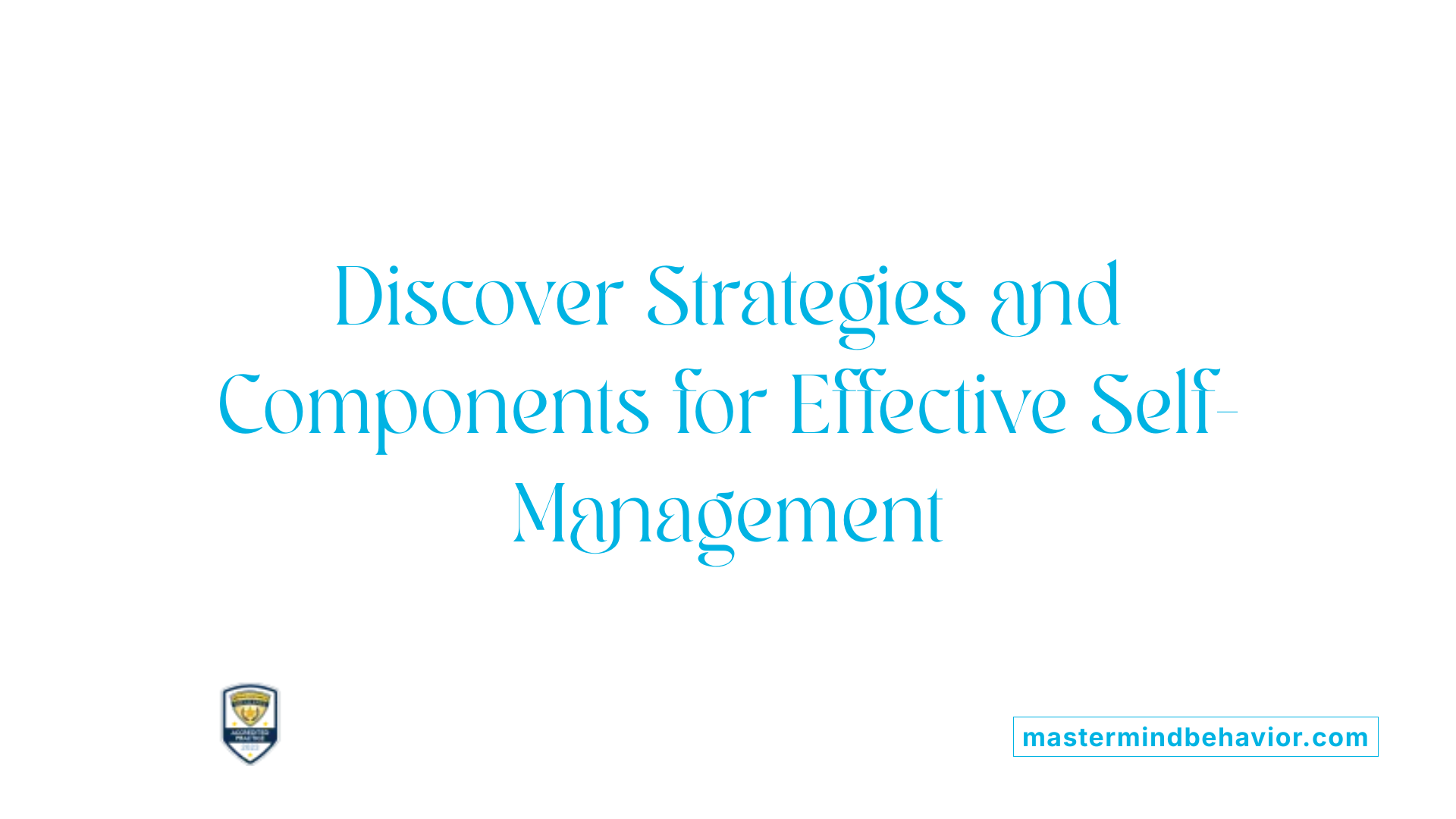
What are some examples of effective self-management strategies?
Effective self-management hinges on a variety of strategies that empower individuals to regulate their behavior, thoughts, and emotions. Organizing time and workspace forms a foundational step, requiring the creation of schedules, to-do lists, and setting precise deadlines to enhance focus and productivity. Establishing routines—such as morning rituals or designated work periods—helps foster consistency and reduces the likelihood of procrastination.
Prioritizing tasks ensures that individuals concentrate on what is most important, preventing overwhelm and facilitating goal achievement. Mindfulness exercises, meditation, regular physical activity, and stress-reducing habits support emotional regulation and mental clarity. Controlling emotions involves recognizing emotional triggers and employing techniques like deep breathing or journaling to maintain composure.
Maintaining a positive attitude and fostering resilience enhances reliability and decision-making capacity. Regularly evaluating progress through self-assessment and being willing to adapt strategies based on outcomes further improve effectiveness. These practices, applied consistently, contribute to sustained self-discipline and growth in various contexts, whether personal, academic, or professional.
What are the fundamental components of self-management interventions?
Self-management interventions are structured approaches designed to promote independent control over personal behaviors related to health, learning, or daily functioning. The core elements include:
- Goal Identification and Definition: Setting specific, measurable, achievable, relevant, and time-bound (SMART) goals that guide behavior change.
- Self-Monitoring: Regularly observing and recording behaviors to assess adherence and progress.
- Behavioral Strategies: Implementing techniques like reinforcement, shaping, and self-monitoring to encourage desired behaviors.
- Cognitive Strategies: Using self-instructions, cognitive restructuring, and visualization to modify thought patterns that influence actions.
- Environmental Adjustments: Changing social settings, visual cues, or physical environments to facilitate or cue desired behaviors.
- Self-Evaluation and Feedback: Comparing actual performance with goals and receiving or providing feedback to enhance motivation and modify behaviors.
- Self-Reinforcement: Applying positive consequences to oneself, such as praise or rewards, to strengthen behavior.
These components work synergistically to foster skill development, independence, and sustained behavior change, applicable across diverse populations and settings.
Practical Steps for Incorporation into Therapy
Self-management strategies are indispensable in contemporary therapeutic practices, offering individuals tools to foster independence, enhance motivation, and sustain behavioral change. Integrating self-management into therapy requires a systematic approach that emphasizes goal setting, data collection, contingency creation, supportive partnerships, and continuous evaluation.
How can self-management be effectively implemented in therapeutic practice?
Successful application begins with assisting clients in defining clear, achievable goals aligned with their personal aspirations or health needs. This process involves guiding clients through establishing specific targets and breaking down behaviors into manageable steps. For example, a client aiming to improve physical activity might set a goal to walk for 20 minutes daily.
Encouraging self-monitoring is another crucial element. Clients are taught to record their behaviors, reactions, or progress, which fosters accountability and creates self-awareness. This can be facilitated through logs, diaries, mobile apps, or wearable sensors that provide real-time feedback.
Building a strong, empathetic relationship between therapists and clients enhances motivation and resilience. By understanding emotional and psychological factors, therapists can tailor strategies that resonate with the client's values and circumstances.
Therapists also help clients develop proactive planning skills, encouraging them to anticipate challenges and identify personal strengths that support change. Emphasizing self-care and overall well-being sustains motivation and heads off burnout.
Regulating behavior, managing time effectively, and personal reflection are integral to embedding self-management skills. Regular check-ins and reviews facilitate the review and refinement of strategies, ensuring adaptation to evolving needs.
What are the steps to implement a self-management program?
Implementing a structured self-management program involves a series of coordinated steps:
| Step | Description | Additional Details |
|---|---|---|
| Goal Specification | Clearly define the target behavior and set measurable objectives | Ensuring goals are SMART (Specific, Measurable, Achievable, Relevant, Time-bound) increases likelihood of success |
| Self-Monitoring | Collect data on behavior through logs, apps, or sensors | Enables clients to see patterns and track progress, fostering motivation |
| Contingency Design | Develop reinforcement schemes like rewards or privileges | Positive reinforcement enhances motivation and consolidates desired behaviors |
| Public Commitment | Make a formal or informal declaration to uphold the goal | Enhances accountability through social or personal stakes |
| Support Partner | Obtain a friend, family member, or peer to support accountability | Provides external encouragement and feedback |
| Evaluation and Plan Adjustment | Regularly review data, assess progress, and modify strategies as needed | Ensures ongoing relevance and effectiveness of the program |
These steps, when executed systematically, support sustained behavior change and adaptation over time.
Building Supportive Partnerships
A fundamental aspect of effective self-management is partnering with individuals who can provide encouragement and accountability. Whether healthcare professionals, friends, or family members, partners help reinforce strategies, provide feedback, and maintain motivation. Training support persons to understand the client's goals and strategies enhances consistency and cohesion.
Evaluation and Plan Redesign
Continuous assessment allows for dynamic adjustments to the program. Monitoring tools can include regular review sessions, progress reports, or digital dashboards. Celebrating milestones, identifying barriers, and brainstorming solutions are part of this ongoing process.
In conclusion, embedding self-management into therapy involves a structured process that empowers clients to take control of their behaviors actively. By emphasizing goal clarity, data collection, contingency planning, supportive relationships, and iterative evaluation, therapists can facilitate meaningful and lasting change.
Role of Self-Regulation and Environmental Factors
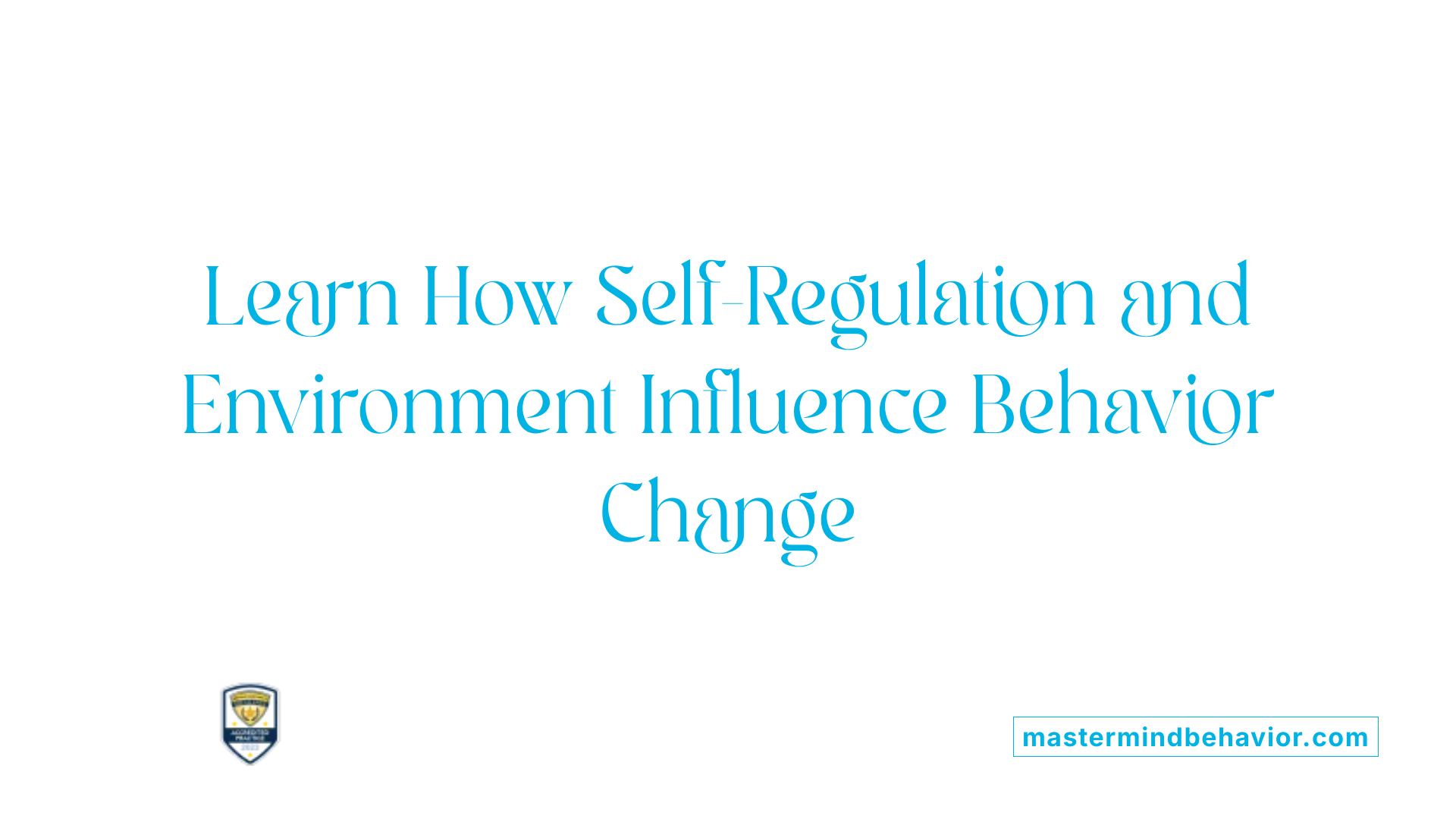
How does self-management relate to self-regulation skills?
Self-management and self-regulation are deeply interconnected. Self-regulation skills serve as the foundational tools that facilitate effective self-management. Self-regulation involves controlling one's emotions, thoughts, and impulses in real-time, enabling individuals to stay focused and maintain composure in various situations.
Self-management extends this concept over a longer period, involving deliberate application of self-regulation abilities such as goal-setting, impulse control, stress management, and perseverance. It requires individuals to plan, monitor, and evaluate their behaviors consistent with personal or clinical goals.
Techniques like self-monitoring and mindfulness cultivate both self-regulation and self-management. For instance, regularly tracking behavior helps individuals recognize patterns that need adjustment, reinforcing self-control and motivation.
Achieving sustained behavior change depends on a solid self-regulation foundation. When individuals can adapt to changing circumstances, stay motivated, and act responsibly, they are better equipped for successful self-management. These skills contribute to resilience, personal growth, and ethical conduct, all vital for long-term success.
What influence does the environment have on behavior, and how can it be modified for better self-management?
The environment plays a crucial role in shaping behavior. It can either act as a facilitator or an obstacle to behavioral change, which is why self-management strategies often emphasize environmental modifications.
Environmental influences include physical surroundings, social contexts, and organizational structures that can trigger or suppress certain behaviors. For example, a cluttered workspace may hinder focus, while a quiet, organized space promotes productivity.
By intentionally altering the environment, individuals can enhance their capacity for self-management. Practical changes include creating dedicated areas for specific activities to establish routines and reduce distractions.
Visual cues, such as charts, signs, or alarms, serve as prompts to reinforce desired behaviors. Social settings can also be adjusted—surrounding oneself with supportive peers or mentors can promote accountability.
Additional strategies involve reducing environmental barriers like temptations, setting up accountability systems, and structuring the physical space to support goal achievement. For instance, placing healthy snacks at eye level encourages better dietary choices.
Overall, modifying the environment provides external supports that align with internal motivation, making it easier to adopt and sustain positive behaviors. These adjustments reinforce self-management efforts by minimizing external triggers of undesired behaviors and creating a consistent context for success.
| Aspect | Strategy | Expected Impact |
|---|---|---|
| Physical environment | Creating designated spaces | Promotes focus and routine development |
| Visual cues | Charts, alarms, prompts | Reinforces behavioral goals |
| Social environment | Support groups, accountability partners | Enhances motivation and accountability |
| Organizational structure | Structured schedules, checklists | Facilitates planning, reduces overwhelm |
| Temptation management | Removing distractions or temptations | Decreases likelihood of undesired behaviors |
Implementing environmental changes complements internal self-regulation skills, facilitating a more effective and sustainable self-management process. Both approaches together empower individuals to maintain behavioral modifications, improve well-being, and achieve personal and health-related goals.
Self-Management in Various Health Contexts
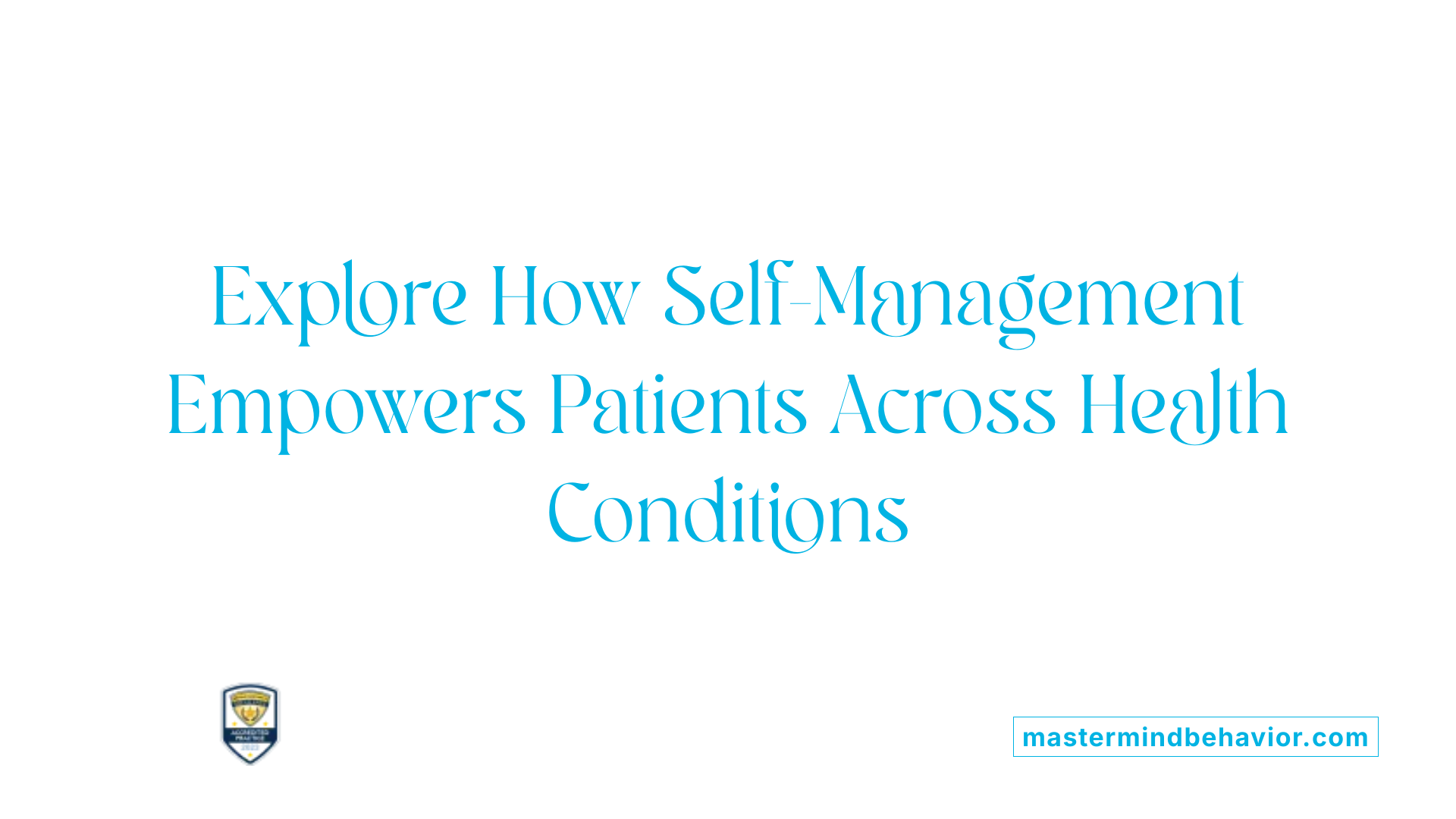
What are the applications of self-management in specific health contexts?
Self-management techniques are vital across a spectrum of health domains, helping individuals take control of their conditions and improve their quality of life. In chronic diseases such as Chronic Obstructive Pulmonary Disease (COPD), self-management is embedded in pulmonary rehabilitation programs. These programs combine education, exercise, and motivational strategies to empower patients, fostering adherence to treatment plans and reducing hospital readmissions.
In neurological rehabilitation and pain management, self-management focuses on pacing activities to prevent fatigue, regulating emotions, and modifying environments to cope with persistent symptoms. Techniques like mindfulness, emotional regulation, and activity scheduling help individuals better manage chronic pain or neurological impairments.
For individuals with autism spectrum disorder (ASD), self-management supports social and academic functioning through structured routines, self-monitoring, and reinforcement. These strategies enable learners to develop independence in behavior regulation, social interactions, and daily living skills, reducing reliance on external interventions.
Research-backed evidence emphasizes that tailored self-management interventions enhance functional independence, facilitate symptom control, and decrease dependency on healthcare services among these populations. Such approaches are adaptable, addressing specific needs whether dealing with physical health, neurological issues, or developmental conditions.
How can physical therapists incorporate self-management strategies?
Physical therapists play a key role in fostering self-management by guiding patients through education, goal setting, and action planning. They encourage active participation, supporting clients in developing personalized strategies that suit their daily routines and environmental contexts.
Practical support includes using interactive programs, such as tele-rehabilitation, that incorporate wearable sensors for remote activity monitoring and real-time feedback. These technologies empower patients to independently manage their activities, track progress, and stay motivated.
Environmental modifications, like rearranging home spaces or providing visual cues, help reinforce self-management goals. Therapists also emphasize the importance of psychological support by incorporating strategies like emotional regulation and motivation enhancement, which are essential for sustaining behavior change.
By fostering a patient-centered approach, physical therapists help individuals build skills like problem-solving, decision-making, and self-monitoring. These skills ensure long-term adherence to exercise protocols, lifestyle changes, and other health-promoting behaviors, ultimately leading to better health outcomes and increased independence.
Supporting Therapists in Implementing Self-Management Strategies
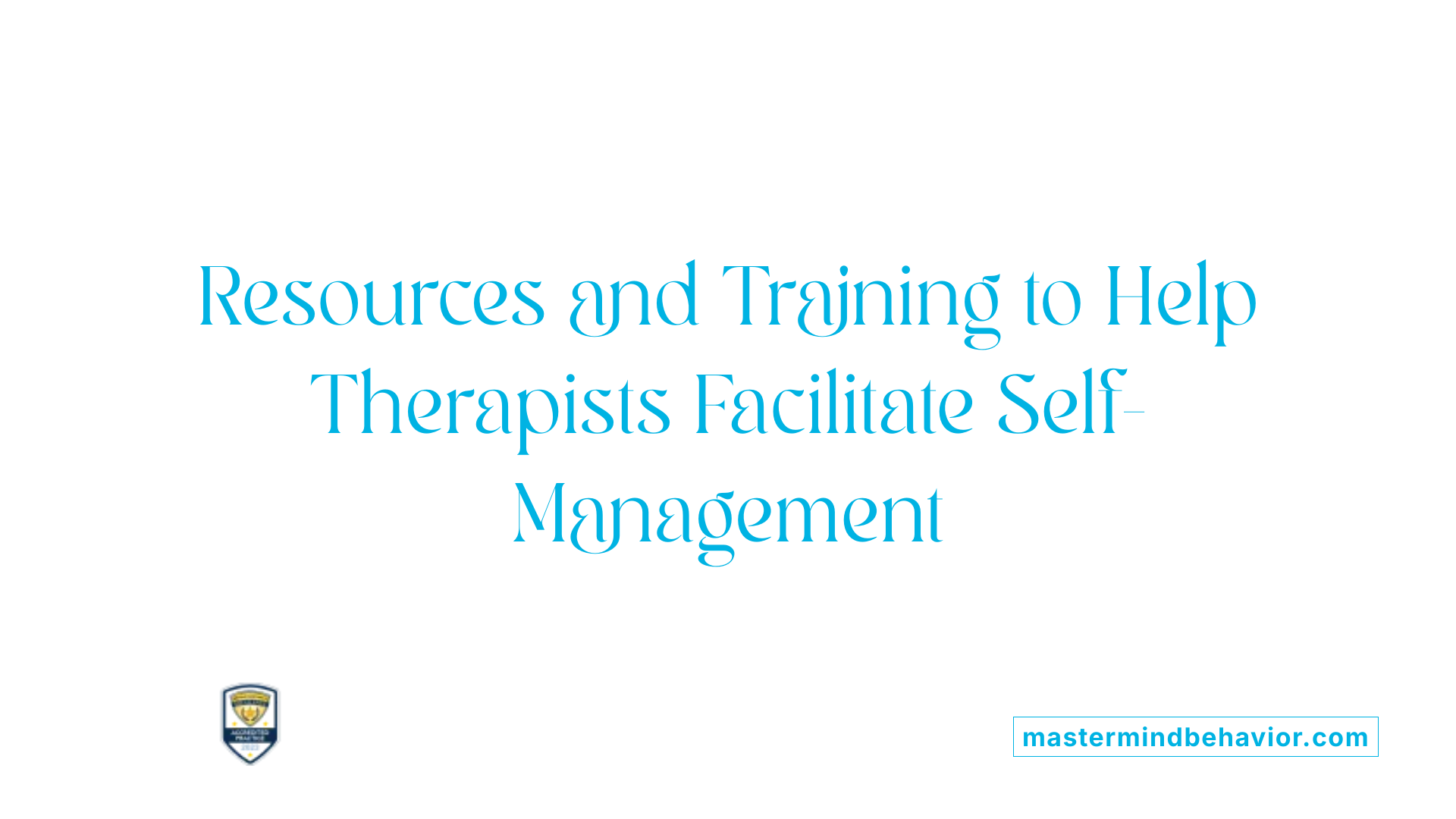
What resources are available for therapists to support self-management implementation?
Therapists aiming to incorporate self-management strategies into their practice can utilize a broad spectrum of resources crafted to facilitate effective support. The Agency for Healthcare Research and Quality (AHRQ) is a prominent source, offering extensive tools, protocols, and evidence-based guides tailored for self-management support. These include structured programs that outline step-by-step processes for engaging patients, educational materials designed to improve health literacy, and training modules that enhance therapist skills.
In addition to governmental agencies, professional societies such as the American Physical Therapy Association (APTA) and the American Occupational Therapy Association (AOTA) publish clinical guidelines that embed self-management as a core component. These resources often provide standardized frameworks, practical checklists, and case examples.
Technology also plays a pivotal role; mobile health (mHealth) applications and tele-rehabilitation tools allow therapists to extend support beyond in-person interactions. Wearable sensors, online monitoring platforms, and real-time feedback systems help track patient progress and sustain motivation, making self-management more accessible and personalized.
Moreover, many organizations offer online training platforms, webinars, and peer consultation networks. Continuous professional education ensures that therapists can stay updated on innovative strategies and emerging evidence, thereby enhancing the quality of self-management support.
How can therapists be trained to effectively support self-management?
Effective training programs are essential to equip therapists with the necessary skills for supporting self-management. Such training should begin with comprehensive education on core principles, including behavior change theories, goal-setting methodologies, and self-monitoring techniques. Understanding the psychological and social factors influencing patient behavior is fundamental to tailoring interventions.
Workshops and seminars—either in-person or virtual—serve as practical avenues for hands-on learning. These sessions can demonstrate techniques such as motivational interviewing, environmental assessments, and the integration of cognitive-behavioral strategies like self-talk and cognitive restructuring.
Ongoing professional development is crucial. Participation in online courses, certification programs, and supervised clinical practice consolidates knowledge and hones skills. Supervision and feedback from experienced clinicians help reinforce proper application, troubleshoot challenges, and adapt approaches to individual patient needs.
Another critical aspect of training involves familiarization with technology-enhanced interventions. Therapists should learn to utilize mobile apps, wearable devices, and telehealth platforms effectively. These tools not only aid in patient engagement but also facilitate remote monitoring and timely feedback.
Emphasizing patient-centered communication techniques during training helps therapists build rapport, identify patient-specific barriers, and foster confidence. These skills motivate patients to actively participate in their own care, a vital factor in successful self-management.
Finally, standardizing the inclusion of self-management strategies within routine protocols helps ensure consistency and maintain quality across practitioners. Embedding these practices into clinical guidelines and care pathways promotes sustainable integration into everyday therapy routines.
Fostering Long-Term Change Through Self-Management
Implementing effective self-management strategies in therapy can significantly enhance patient outcomes, foster independence, and promote sustainable behavior change. By understanding its core components—from goal setting and self-monitoring to environmental modifications—and applying tailored techniques, therapists can empower clients to take control of their health and behaviors. The integration of self-regulation skills, ongoing evaluation, and technological supports creates a comprehensive framework that benefits diverse populations and health conditions. As research continues to validate these approaches, therapists are encouraged to embed self-management into their practice, ensuring patients develop lifelong skills for well-being and resilience.
References
- Self-Management: How to Change Your Own Behavior - Psych Central
- Self Management Technique for Behavioral Change
- Self-Management Programs and the Pursuit of Behavior Change
- Self-Management Interventions
- 5 Tips for Better Self-Management | Psychology Today
- Promoting the Use of Self-management Strategies for People ... - jospt
- Self-Management: Definition, Skills & Strategies - The Berkeley Well ...
- Behavioral self-management strategies for practice and exercise ...
- What are strategies for self-management of personal support?
- How to Implement Self-Management Support in your Practice - AHRQ
Recent articles

ABA Therapy For Building Self-Regulation And Coping Skills
Harnessing ABA Therapy to Empower Emotional and Behavioral Mastery in Autism

ABA Therapy For Building Skills In Independent Decision Making
Empowering Autistic Individuals Through ABA: A Pathway to Autonomy

Collaborative Communication Between Therapists and Families
Building Bridges: The Essential Role of Collaboration in Autism Therapy

How ABA Helps Develop Adaptive Behavior Skills Over Time
Unlocking Independence: The Role of ABA in Building Adaptive Skills

The Role of Parent Priorities in Designing ABA Goals
Collaborative Goal-Setting: Aligning ABA Therapy with Family Priorities

Translating ABA Goals into Everyday Functional Skills
Bridging Theory and Practice: How ABA Therapy Enhances Daily Life for Individuals with Autism



